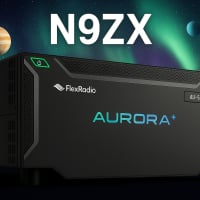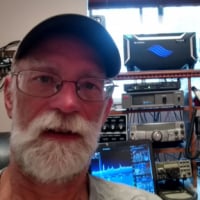SmartSDR v4.1.3 | SmartSDR v4.1.3 Release Notes
SmartSDR v3.10.15 | SmartSDR v3.10.15 Release Notes
The latest 4O3A Genius Product Software and Firmware
Need technical support from FlexRadio? It's as simple as Creating a HelpDesk ticket.
Aurora FAQ

Why is the Aurora transmitter so efficient?
The Polar Explorer © 2025 transmitter is so efficient because it replaces legacy linear amplification with switch-mode amplification—specifically Class D amplifiers—and leverages digital signal processing (DSP) to separate and handle the signal’s envelope (amplitude) and phase components independently.
Why is the Aurora radio so small for 500W?
The transmitter is extremely efficient, which results in the need for a much smaller heat sink. The reduced heat sink size and transmitter all fit inside the same space as a traditional 100W amplifier.
I see the radio weighs only 18 pounds (8kg).
This doesn’t include the 500W transmitter and associated power supply, right?
It does. Because of the high efficiency of the Aurora transmitter, a small power supply, a small heat sink, and the transmitter all fit into a compact space. The Aurora radio has it all: receiver, 500W transmitter, and AC to DC supply!
What about Adaptive Predistortion - SmartSignal?
SmartSignal is included with all Aurora models.
I understand that Aurora is around 80% efficient.
I checked, and my current radio is about 40-50% efficient. This means I’m saving about half the power, with Aurora, right?
Actually, no! The math around efficiency is a little more complex. A 100W transmitter that is 40% efficient generates 150W of heat (100/0.4 = 250W of input power. 250W - 100W output = 150W of heat). A 100W transmitter at 80% efficiency generates only 25W of heat (100/0.8 = 125W. 125W - 100W output = 25W).
The heat generation of the 80% efficient transmitter is only 17% of that of the 40% efficient amplifier. This is a 6x reduction in the heat generated! This allowed FlexRadio to put a 500W transmitter in the space of a 100W linear amplifier!
Can I integrate this radio into a remote station setup?
Absolutely—Aurora models are built on the same amazing remote platform that all FLEX-8000 radios are built on. The same API, with extensions for Aurora, is available as well as SmartLink capabilities. Aurora is the perfect high-power remote HF hardware.
Will I need an external tuner with this radio?
An internal antenna matching unit capable of matching up to an SWR of 3:1 is a standard feature. The core Aurora technology is more sensitive to impedance mismatches than a linear amplifier.
As a result, all Aurora models come with an integrated tuner to ensure the impedance presented to the transmitter is close to 50Ω. Use of the integrated tuner will be required for any non-resonant antennas.
How efficient is the Aurora transmitter compared to legacy linear HF amplifiers?
This radio boasts 80% efficiency, thanks to its use of polar modulation and high-efficiency transmitter architecture. Legacy linear amps often run around 40-60%, so this design cuts waste heat by 70-80%.
What does 80% efficiency mean in practical terms?
It means that out of every 100 watts of supply power drawn from the wall, about 80 watts go to your actual RF signal, and only 20 watts are lost as heat. That’s a major improvement over typical HF rigs and amps.
I already have a radio at home. What would the Aurora buy me?
The most obvious addition if you have a 100W radio is an increase in power to 500W. In addition to this, the Aurora radios are 80% efficient, so the electricity required to make 500W is less than half of what it would be with a traditional radio and an external amplifier.
As a result, you save on operating costs. Also, since the heat generated is about one-fifth to one-sixth that of a legacy 500W amplifier, it lowers cooling requirements on your house and can help keep an even temperature in your shack.
Finally, because Aurora is completely integrated, your shack with Aurora is much cleaner with fewer wires, cabling, and devices.
I like to operate POTA or other portable operations.
Isn’t 500W overkill? What would the Aurora buy me?
The input power required for a legacy 500W linear amplifier is 1,000-1,250W supply power to make that 500W output. This is on top of the 100W radio sending power to the amplifier, which will draw around 250W during transmit.
This means your legacy 500W amplifier set up would need 1,250–1,500W of input power to make that 500W output. Aurora needs 650-700W of input power to make 500W of output power. On top of that, a legacy 100W/500W configuration weighs about 47 pounds. Compare that to the 18-pound Aurora transceiver!
That’s a more than 50% reduction in input power and a 62% reduction in weight for a 500% increase in power output! Aurora also eliminates all the cabling to connect a legacy 500W station together.
Finally, if you’re using a generator, solar or any other off-grid power system, the system itself can be significantly smaller or use less fuel.
I’m planning a DXpedition.
Would there be any benefit of using an Aurora radio?
DXpeditions are fraught with logistical challenges. Aurora provides a 500W transmit capability in an 18-pound integrated radio that uses half the electricity (and therefore fuel) of a legacy 500W configuration.
Aurora is a 500W station that can literally be put inside a carry-on bag. The advantages are similar to the POTA discussion above, but cannot be underestimated for a DXpedition.
Do I need a big cooling setup or fans for this?
Not at all. With far less heat being generated, cooling requirements are dramatically reduced. It still includes active cooling, but it's much quieter and more compact than you might expect for 500W output.
Will this reduce the need for external heat dissipation in my shack?
Yes. Less waste heat means your shack stays cooler, especially important for smaller or poorly ventilated rooms.
Does high efficiency mean better reliability?
Generally, yes. Less thermal stress on components leads to longer life, fewer thermal shutdowns, and overall more stable performance during long operating sessions.
Can I operate outside the Amateur Radio bands for MARS, SHARES, etc?
No. This transmitter is designed strictly for the amateur bands and the hardware is not capable of transmission outside of normal amateur HF/6m bands.
What supply voltage is required?
The radio can operate from 100 to 240VAC thanks to its autosensing built-in AC power supply, allowing it to deliver its full power. This means that for those operators with only 120VAC line voltage, the radio can still develop 100% of its maximum output.
Can I operate the radio at 13.8V DC?
No. You must use 80 to 264 VAC as a supply voltage.
What is the maximum power on 6m?
The maximum power on 6m is 200 watts.
Is the ATU included?
Yes, the ATU is included in every model that handles up to a 3:1 SWR.
Can I hook up an external ATU?
All Aurora transceivers include an integrated 3:1 500W tuner. An external tuner can be used instead if preferred. Note that the tuner needs to be capable of at least a 500W input and care should always be taken when dealing with high-power RF.
Can I use the radio with an external amplifier?
Yes, you can—but proceed with caution. It's critical to avoid overdriving the connected amplifier. Doing so can cause serious damage, not just to the external amplifier but also to the transmitter inside the radio itself. This may impact your radio and amplifier warranty.
How much does it cost?
Please see our website for the most current pricing. www.flexradio.com
Will there be an M Model?
Yes. The AU-510 and AU-520 are also available as an AU-510M and AU-520M.
Can I trade in my radio to aid the purchase of the AU-500 Series Radio?
Not at this time.
Does Aurora support transverters?
Yes, transverters can be attached to the XVTR ports in the same fashion as the FLEX-6000 and FLEX-8000 series.
Comments
-
So many advantages! I am in. Put my money down for group 1. 73 N8VY1
-
Same here. Now the wait begins.
James
WD5GWY
0 -
Me too, group 1 N9ZX1
-
Is the extended transmit module available for the Aurora?0
-
From the FAQs above:
Can I operate outside the Amateur Radio bands for MARS, SHARES, etc?No. This transmitter is designed strictly for the amateur bands and the hardware is not capable of transmission outside of normal amateur HF/6m bands.
1 -
I see where out-of-band is not supported. If a new band becomes available, can the software be updated to allow its use??
Also, will there be a "Maestro" type interface in the future??
0 -
Hi Andrew, the issue is that the low pass and band pass filter boards are physical devices and would need to be replaced to allow additional bands. I think it is highly unlikely that Flex (or any manufacturer) will be able to support new bands with existing equipment unless the bands are very close to existing frequency allocations.
The Aurora already works with the Maestro and there will be an "M" model available as well for those who prefer a front panel.
0 -
Will there be a version of the software that will operate on an Ipad to permit remote operation?
0 -
You may want to direct your question to the author of the iOS application. He does not monitor the community.
0
Leave a Comment
Categories
- All Categories
- 379 Community Topics
- 2.1K New Ideas
- 631 The Flea Market
- 8.2K Software
- 123 SmartSDR+
- 6.4K SmartSDR for Windows
- 184 SmartSDR for Maestro and M models
- 430 SmartSDR for Mac
- 271 SmartSDR for iOS
- 259 SmartSDR CAT
- 193 DAX
- 382 SmartSDR API
- 9.3K Radios and Accessories
- 39 Aurora
- 265 FLEX-8000 Signature Series
- 7.2K FLEX-6000 Signature Series
- 949 Maestro
- 56 FlexControl
- 866 FLEX Series (Legacy) Radios
- 925 Genius Products
- 463 Power Genius XL Amplifier
- 337 Tuner Genius XL
- 125 Antenna Genius
- 297 Shack Infrastructure
- 209 Networking
- 460 Remote Operation (SmartLink)
- 144 Contesting
- 788 Peripherals & Station Integration
- 139 Amateur Radio Interests
- 1K Third-Party Software

